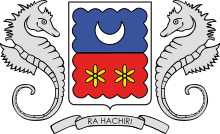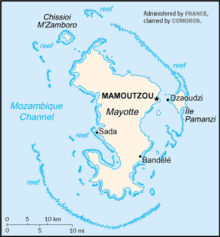History of Mayotte
The story of Mayotte is the story of the Mayotte archipelago in the Indian Ocean , which is part of the Comoros archipelago and which today forms a French overseas territory ( Collectivité d'outre-mer ). It consists of the main island of the same name, Mayotte, the two secondary islands Île Pamanzi and Ile M'Zamboro, as well as some very small offshore islands.
Pre-colonial history
Like the other islands of the Comoros , Mayotte has been humanly settled since around 500 AD, originally by Austronesian seafarers from the area of today's Indonesia , who came here directly via the Indian Ocean or with a stopover via the island of Madagascar in the south , and later through Bantu from the coast of East Africa. According to the Chronicle of Kilwa , Arab - Persian traders from the Persian city of Shiraz , called Shiraz , appeared on the Comoros as early as the 10th century and brought Islam there . A Swahili culture arose on the islands including Mayotte and the export-oriented production of iron on the island is attested for the 11th or 12th centuries. During this phase, traces of the Shirazi on Mayotte can also be found in the necropolis of Bagamoyo . Around 1500 a sultanate, called Maore or Mawuti (from the Arabic جزيرة الم, which means something like "island of the dead") emerged on the island. In 1566, the oldest mosque on the island of Mayotte was built in Chingoni. In 1503 Portuguese sailors first reached the island and recorded them on their maps.
Towards the end of the 18th century, all the islands of the Comoros suffered from slave hunts by the Malagasy people of the Sakalava . But they only settled permanently on Mayotte, which is why Kibushi , a Malagasy language, is still spoken in some villages here . European pirates also haunted the islands between 1600 and 1800 and the troops of the sultan of the neighboring island of Anjouan devastated the island in the 1740s. Between 1790 and 1820, the Sakalava slave hunts increased dramatically. After all, Mayotte was largely depopulated by the early 19th century, from an estimated 12,000 residents in the 16th century to less than 5,000 in the first French census in 1843.
In 1832 Mayotte was conquered by Andriantsoly , a former king of the kingdom of Iboina in Madagascar; In 1833 from the neighboring Sultanate of Mwali ( Mohéli in French) and again in 1835 from the Ndzuwani Sultanate (Sultanate of Anjouan, which left behind a representative of his power with the unusual Islamic title of Kadi ). In 1836 the island gained its independence for the last time under a local sultan.
Ruler of the island since 1500
| Beginning of rule | The End | Surname | comment |
|---|---|---|---|
| since 1500 | Maoré or Mawati | Beginning of the first sultanate | |
| 1700 | 1714 | regent | |
| 1714 | 1720 | Monavo bint Mwinye, Fani (Regent) | |
| 1720 | 1727 | Abu Bakr bin Omar | |
| 1727 | 1752 | Salim bin Abi Bakr | |
| 1752 | 1790 | Boina combo ben Salim | |
| 1790 | 1807 | Salim II | died in 1807 |
| 1807 | 1817 | Suhali bin Salim | died in 1817 |
| 1817 | 1829 | Mawana Amadi bin Boina combo | died in 1829 |
| 1829 | 1829 | Moge Muku | |
| 1829 | 1832 | Boina Kombo bin Amadi | |
| 1832 | 1833 | Andriantsoly | 1 time |
| 1833 | 1835 | No sultan of his own, affiliation with Mohéli , later with Anjouan | |
| November 19 1835 | 1836 | Umar | Governor and Kadi |
| 1836 | 25.3.1841 | Andriantsoly | 2 times |
French colonial times
Protectorate until 1912
On April 25, 1841, the French declared Mayotte a protectorate (a corresponding document was ratified on June 13, 1843) and began from here to exert influence on the other islands. In 1847 they forbade slavery on Mayotte and promoted the settlement of the island, largely depopulated by Malagasy raids and slave hunts, with released slaves and French settlers. Despite the prohibition of slavery, workers, especially from the nearby Portuguese city of Mozambique , were “kept” under conditions similar to slavery in the inland sugar cane fields. Only from 1878 did the plantation owners adhere to a decree that forbade workers to be put in iron chains. In 1864 the island's first state school was opened in Dzaoudzi . On March 13, 1896, the city of Mamoudzou on Mayotte was declared the capital of the entire Protectorate of the Comoros.
Colonial period 1912–1946
In 1912 the "Protectorate of the Comoros" including Mayotte received the status of a colony, from 1914 they were administered from the French colony of Madagascar. The colonial societies thereby lost their direct rule, but remained extremely powerful. In the 1930s they owned 46% of the land area of Grand Comore, 37% of Anjouan, 22% of Moheli and 15% of the area of Mayotte. During the Second World War , the islands that had declared themselves for the Vichy government of Marshal Philippe Pétain were temporarily occupied by British troops.
Overseas territory since 1946
In 1946 the Comoros, which were no longer administered from Madagascar, were given the status of a French overseas territory with administrative autonomy. In 1956, France guaranteed the right to vote and the transition to full internal autonomy, which was not finally granted until January 1968. In 1957, Mohammed Ahmed was elected head of government as a candidate for a joint list of political groups on the islands. After a referendum in 1958, the state parliament approved the retention of the status of a French overseas territory. Only Mayotte's representatives had pleaded for closer ties to France and called for the status of a department.
Separation from the Comoros in 1975
Mayotte was the only island in the archipelago that maintained ties to France and renounced independence in the 1974 and 1976 votes (with 63.8% and 99.4% approval). The Union of Comoros , in which all the other islands of the Comoros archipelago united to form an independent state in 1975, has since then been claiming Mayotte and not recognizing that it belongs to France. In doing so, the Union relies on a resolution of the UN Security Council from 1976 in which 11 out of 15 members recognized the sovereignty of the Union of Comoros over the island of Mayotte. However, France vetoed the resolution. Since then, the General Assembly of the United Nations has passed several similar resolutions, the last time the question was discussed there in 1995. In the same year, France introduced a visa requirement for citizens of the Union of Comoros.
"Collectivité départementale" Mayotte 2001 to 2009
The economic boom on the island led to a growing influx of economic immigrants from the rest of the Comoros. In 1995, the French government under Édouard Balladur abolished free travel between Mayotte and the islands of the rest of the Comoros. Since then, Comorians also need a visa for Mayotte. Nonetheless, refugees arrive on the island every night, hoping to survive there for 13 years - their children then become French citizens. Today, over 60,000 illegal immigrants live on Mayotte, mostly people from the surrounding islands. A small contingent of soldiers serving the French state ( Foreign Legion ) is stationed on the island .
On July 11, 2001, 73% of the island's population voted for a new political status as collectivité départementale . Since then, Mayotte has had a similar legal position to the French overseas departments , but unlike them it was not part of the European Union . In the French National Assembly, Mayotte was represented by a deputy and in the Senate by a senator.
On March 28, 2003, the French constitution was modified and the name Mayotte was listed in Article 72 under the " Overseas Territories " as "territorial authorities with special status".
Mayotte department from 2011
In a further referendum on March 29, 2009, the residents of Mayotte approved that their island should be designated a department and exercise the powers of the overseas departments and regions under Article 73 of the French Constitution . With a participation of around 61%, around 95% of those surveyed agreed. The implementation came into force with the new election of the Mayotte General Council in 2011. The island has been the 101st department in France since March 31, 2011 and part of the European Union since January 1, 2014. The main reason for the vote was the prospect of better social benefits and funds from regional funding from the European Union.
Individual evidence
- ↑ Walter Mayr: START AND CRASH: THE INSEL LABORATORY . In: Spiegel Special from 2007-05-22 . No. 2 , 2007.
- ↑ Schicho p. 26
- ↑ Markus Schönherr: The dream of Paris . welt-sichten.org . May 22, 2015
- ↑ Constantin Schreiber on the refugee island Mayotte. In: Deutsche Welle. June 24, 2007, accessed June 26, 2016 .
- ^ French embassy in Germany: overseas regions
- ↑ Result of the popular consultation on 29 mars 2009 in Mayotte. Archived from the original on January 13, 2010 ; Retrieved June 26, 2016 (French).
literature
- Walter Schicho: Handbook Africa. In three volumes . Volume 1: “Central Africa, Southern Africa and the States in the Indian Ocean”, Brandes & Apsel, Frankfurt am Main 1999, ISBN 3-86099-120-5 .



